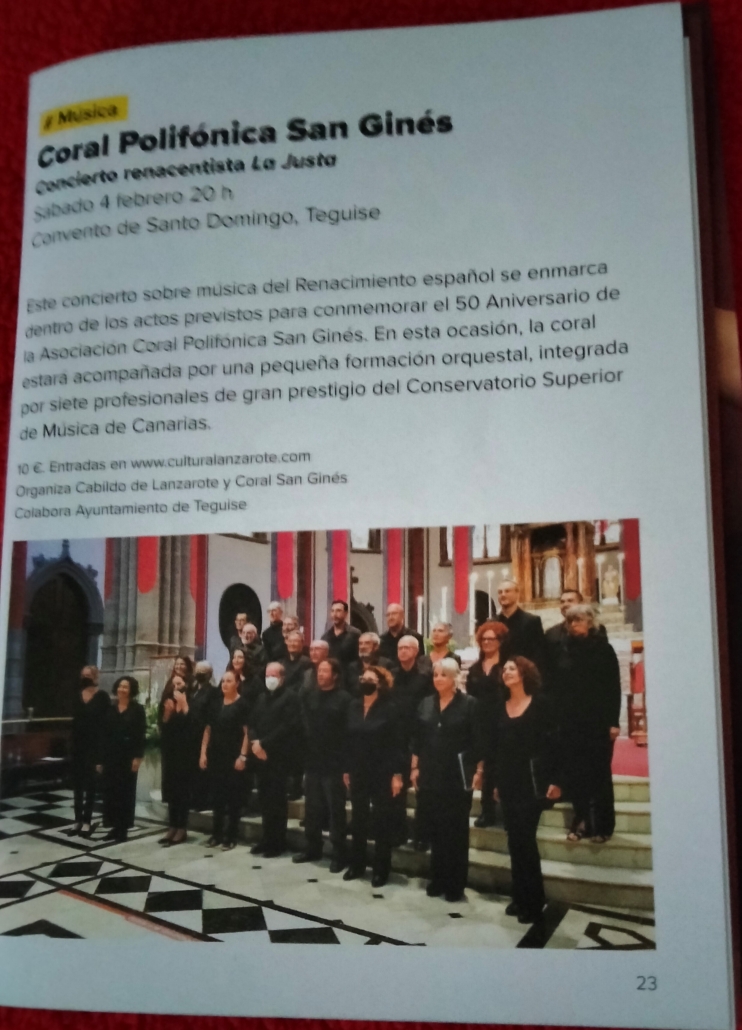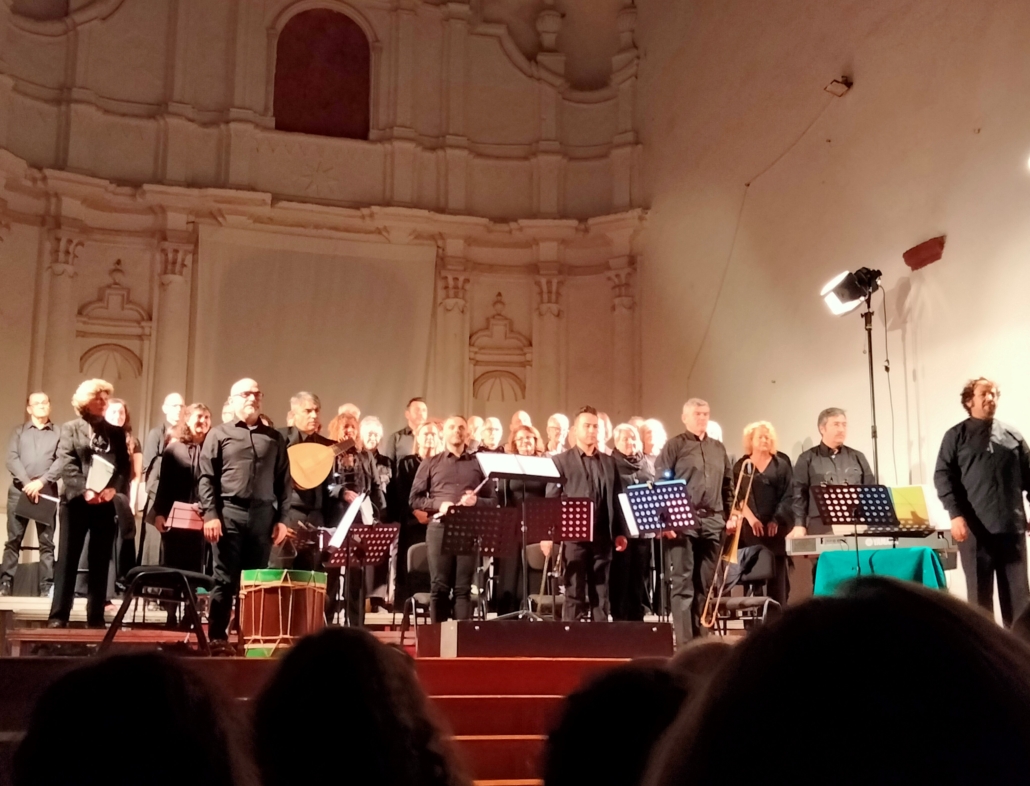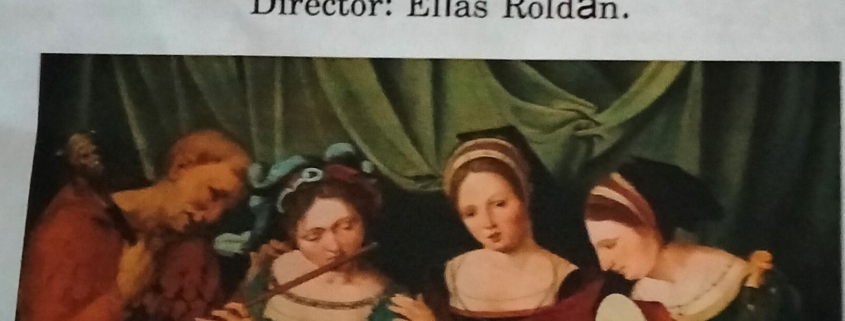CONCIERTO RENACENTISTA
CONCIERTO RENACENTISTA
Concert “The Fair”
San Ginés Polyphonic Choir
Covento de Santo Domingo, Teguise, Lanzarote
February 2023
concert review by Norman Warwick

This short concert was delivered to commemorate the acts of commemoration of the 50th Anniversary of the San Ginés Polyphonic Choir Association.
The central work of the concert was “La Justa”, by the composer Mateo Flecha “el Viejo” (1481-1553), in which, through music, a medieval battle between good and evil is recreated. To complete the repertoire, other works by various Spanish authors from the Renaissance period were also included.
The choir was accompanied by a small orchestral formation, made up of seven professionals from the Conservatorio Superior de Música de Canarias.

Renaissance literally means “rebirth”.
The musical Renaissance period lasted from 1400-1600AD and was a time of huge growth and development, with music becoming more expressive, varied and complex.
Composers had more freedom to write as they pleased and technological developments meant that their music could reach more people.
Religious choral music was dominant at the beginning of the Renaissance period, with much of it building upon the polyphony (music which has two or more simultaneous independent melodic parts) that developed at the end of the Medieval period.
Motets and masses were two common examples of this, with the latter forming part of the church’s liturgy.
Sacred and secular styles began to influence each other: the madrigal (traditionally an unaccompanied non-religious song for a number of voices) was adopted as a church form, while secular composers began to write motets.
At the beginning of the Renaissance period opportunities for secular composers were limited, with most employment coming via the courts (households and residences of sovereigns), which hired musicians as performers, teachers and composers.
But secular music increased in popularity as time went on, and composers could now take commissions from wealthy amateurs, whilst the new printed music also provided financial opportunity.
The Protestant Reformation also meant that now both Catholic and Protestant churches required music for their respective services.
Secular music was largely vocal, but the period saw the development of instrumental music in its own right.
This was no longer music for dancing or accompaniment, for example, but pieces to be listened to seriously.
This was in keeping with a general shift in the Renaissance period towards the idea of creating art for art’s sake.
William Byrd’s Fantasia (an instrumental imitation of a motet) is an example of this:
The modal harmonic system of the Medieval period – music based on scales, or modes – remained in place at the beginning of the Renaissance era.
The rules for counterpoint (the relationship between simultaneous interdependent musical lines) became more complicated and strict regarding which intervals are considered consonant and which are dissonant.
Intervals of a third and a sixth began to be used, and this led to the first use of triads – three-note chords which underpin much Western music today.
Aside from the strict rules surrounding counterpoint, composers had much more freedom to be expressive.
Many now tried to include emotion in their music, and this was aided by a much greater vocal range in comparison to the Medieval period, and much greater variety in elements like rhythm and form.
Richer textures started to emerge, with composers utilising four or more independent parts. Increasingly they would try to make these parts blend together, with imitation a key device that was used to help achieve this.
Important Renaissance composers include:
Josquin des Prez (1450/55-1521) – a Frenchman who wrote both secular and sacred works
Giovanni Pierluigi da Palestrina (1525–1594) – an Italian composer of religious works, and a famous exponent of the Roman School
Thomas Tallis (1505 – 1585) – one of England’s greatest composers, best known for his choral works
Guillaume Du Fay (1397–1474) – Franco-Flemish composer and music theorist
Orlande de Lassus (1530–1594) – Franco-Flemish composer of polyphonic music
Many instruments used in the Renaissance era were precursors to modern instruments, with some of them developing into new forms around this time.
Brass instruments included the trumpet, which at this point had no valves and was used extensively in the military, and the sackbut, an early version of the trombone which replaced the slide trumpet.
The viol, or viola da gamba, was a six-stringed instrument that was played with a bow whilst it rested on the floor, similarly to a modern day ‘cello.
The lyre was another member of the string family: similar to a miniature modern-day harp, it was strummed with a plectrum rather than plucked with the fingers.

In the tradition of a bluffer´s guide to classical music we realised we have delivered our reports on Baroque and Rennaisance music in the wrong chronological order, This was not entirely our fault, as the baroque concert was delivered as the final Lanzarote offering from the 39th Annual Canary Islands Festival of International Classical that was part of a tihgly woven itinerary of several orchestras and ensembles all delivering concerts across our eight islands. It took place the evening before this concert, which had been independently organised by local offices prior to venues and dates being announced by the Festival organisers.
You might think that we at sidetracks and detours could have changed our publishing order to reflect the chronology of the two types of music, but have some publishing deadlines that are set in stone by oibligations and loyalty to some venues and performers
Still, allow us to describe what we saw and heard on this occasion. We saw an ensemble of nine or ten musicians, and a choral team of around forty, interpreting five hundred year old music on instruments just like those used at the time. The percussion, all held in the hands of one man, Kima Marthiez was superb; echoey, rickety and absolutely precise. There was a cornet style instrument that might actually have been a trombone, played by Jose Antonio Padilla Melian. The playing of the vehuela y laUd renacentists, a lute like instrument, was in the hands of Gustave A. Navarro Torres and the organ was played by Vincent Br Soler. The violinsts were Crista Rubebe Delgade Bautista and Francisco Blay Martinez.
The soprano solist Lalar Bitar Farah, and her voice almost served as another instrument, and she delivered perfectly.
Director Elias was a rightly proud conductor, as a packed hall gave standing ovations the Asociacion Coral Polifonica San Gines, from Arrecife (left).
A capital city in name, Arrecife would be a town in the UK, being about the same surface area and population as Rochdale where I sued to live. And yet this felt like a world class performance by skilled players to a knowledgeable and appreciative audience. Credit to all concerned.




Leave a Reply
Want to join the discussion?Feel free to contribute!